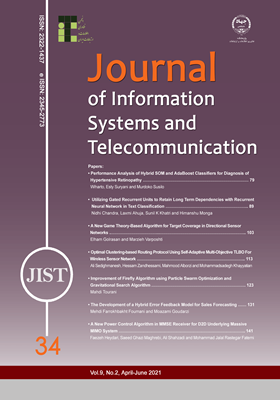-
-
List of Articles
-
Open Access Article
1 - Performance Analysis of Hybrid SOM and AdaBoost Classifiers for Diagnosis of Hypertensive Retinopathy
Wiharto Wiharto Esti Suryani Murdoko Susilo -
Open Access Article
2 - Utilizing Gated Recurrent Units to Retain Long Term Dependencies with Recurrent Neural Network in Text Classification
Nidhi Chandra Laxmi Ahuja Sunil Kumar Khatri Himanshu Monga -
Open Access Article
3 - A New Game Theory-Based Algorithm for Target Coverage in Directional Sensor Networks
Elham Golrasan marzieh varposhti -
Open Access Article
4 - Optimal Clustering-based Routing Protocol Using Self-Adaptive Multi-Objective TLBO For Wireless Sensor Network
Ali Sedighimanesh Hessam Zandhessami Mahmood Alborzi Mohammadsadegh Khayyatian -
Open Access Article
5 - Improvement of Firefly Algorithm using Particle Swarm Optimization and Gravitational Search Algorithm
Mahdi Tourani -
Open Access Article
6 - The Development of a Hybrid Error Feedback Model for Sales Forecasting
Mehdi Farrokhbakht Foumani Sajad Moazami Goudarzi -
Open Access Article
7 - A New Power Control Algorithm in MMSE Receiver for D2D Underlying Massive MIMO System
Faezeh Heydari Saeed Ghazi-Maghrebi Ali Shahzadi Mohammad Jalal Rastegar Fatemi
-
The rights to this website are owned by the Raimag Press Management System.
Copyright © 2017-2025







